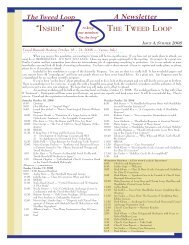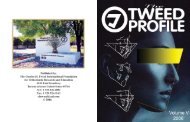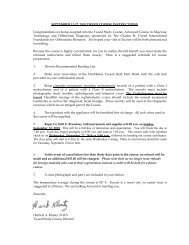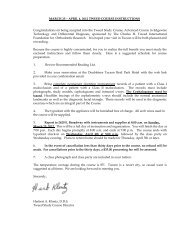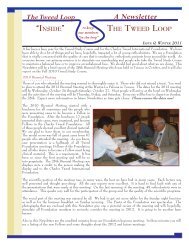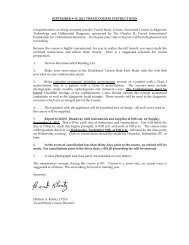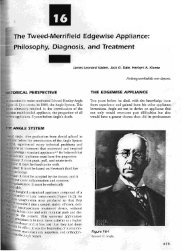the tweed profile - The Charles H. Tweed International Foundation
the tweed profile - The Charles H. Tweed International Foundation
the tweed profile - The Charles H. Tweed International Foundation
Create successful ePaper yourself
Turn your PDF publications into a flip-book with our unique Google optimized e-Paper software.
FACIAL ESTHETICS – A VALID TREATMENT CONSIDERATION?<br />
ED OWENS<br />
JACKSON, WYOMING<br />
Through <strong>the</strong> annals of time, symmetry, harmony and proportion<br />
of <strong>the</strong> human form have caught <strong>the</strong> eye of man. <strong>The</strong>se<br />
qualities, which are <strong>the</strong> foundation of <strong>the</strong> visual interpretation<br />
of beauty, give pleasure to <strong>the</strong> senses. It has evolved<br />
thru thirty five thousand years of artistic endeavor. Some<br />
of <strong>the</strong> earliest depictions of human form have been found in<br />
pteryglyphs and carvings (Figure 1). All civilizations from<br />
<strong>the</strong> Paleolithic era thru <strong>the</strong> Renaissance had <strong>the</strong>ir own concept<br />
of facial beauty (Figure 2). Leonardo and Michelangelo<br />
were very influential with <strong>the</strong>ir paintings and sculptures as<br />
in <strong>the</strong> Mona Lisa and <strong>the</strong> David. As evidenced in his notebooks,<br />
Da Vinci sought <strong>the</strong> ideal facial proportions. He defined<br />
proportion as <strong>the</strong> ratio between <strong>the</strong> respective parts and<br />
<strong>the</strong> whole. From <strong>the</strong> Renaissance to <strong>the</strong> present day, art and<br />
sculpture have influenced our interpretation of facial beauty<br />
and <strong>the</strong> human form.<br />
Figure 1. Pteroglyphs<br />
While at St. Louis University, Edward Hartley Angle, <strong>the</strong><br />
founder of our specialty, was strongly influenced by <strong>the</strong> artist<br />
Edmund Wuerpel. Wuerpel told Angle that “<strong>the</strong> principle<br />
consideration is that we shall encourage <strong>the</strong> thought<br />
that we shall become addicted to <strong>the</strong> observation of es<strong>the</strong>tic<br />
relations”. We, as orthodontists, should be concerned with<br />
<strong>the</strong> concept of facial es<strong>the</strong>tics because of <strong>the</strong> influence our<br />
treatment has on it. <strong>The</strong> results of our work can positively<br />
or negatively affect self-image, self-confidence and social<br />
ability.<br />
FACIAL ESTHETICS – A PERSPECTIVE<br />
In order to develop an appreciation for facial es<strong>the</strong>tics, we<br />
must first develop a perspective for it. To us as orthodontists,<br />
our focus on <strong>the</strong> face is concentrated on <strong>the</strong> dental and<br />
<strong>the</strong> soft tissue aspects. Dentally, we evaluate <strong>the</strong> teeth ansd<br />
<strong>the</strong>ir position in <strong>the</strong> face. We look at <strong>the</strong> amount of tooth<br />
and or gingival display. We ask ourselves, is <strong>the</strong> smile “too<br />
gummy”? <strong>The</strong> presence or absence of large buccal corridors<br />
quantifies <strong>the</strong> appearance of <strong>the</strong> buccal segments within <strong>the</strong><br />
commissures of <strong>the</strong> mouth. <strong>The</strong> smile arc relates <strong>the</strong> curvature<br />
of <strong>the</strong> upper incisal edges to <strong>the</strong> lower lip. Anterior<br />
dental crowding also effects our perception of <strong>the</strong> harmony<br />
of <strong>the</strong> face.<br />
Probably more noticeable than <strong>the</strong> position of <strong>the</strong> teeth in <strong>the</strong><br />
mouth is <strong>the</strong> effect <strong>the</strong> soft tissue drape has on <strong>the</strong> shape of<br />
<strong>the</strong> face. In evaluating <strong>the</strong> soft tissue we must look at <strong>the</strong> aspects<br />
of <strong>the</strong> <strong>profile</strong>. Ideally,<br />
<strong>the</strong> face should be divided<br />
into thirds.<br />
3<br />
Figure 2.Thru <strong>the</strong> Renaissance<br />
From <strong>the</strong> hairline to <strong>the</strong> brow<br />
line, from <strong>the</strong> brow line to<br />
<strong>the</strong> base of <strong>the</strong> nose, and<br />
from <strong>the</strong> base of <strong>the</strong> n use to<br />
<strong>the</strong> bottom of <strong>the</strong> chin (Figure<br />
3). <strong>The</strong> upper lip should<br />
not be straight. It should<br />
have a slight forward cant<br />
Figure 3. Proportional thirds of<br />
<strong>the</strong> ideal face



